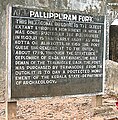Pallipuram Fort
This article includes a list of references, related reading, or external links, but its sources remain unclear because it lacks inline citations. (October 2012) |
| Pallippuram Fort | |
|---|---|
Paliport Castelo em Cima (Castle on the Top) | |
| Pallippuram, Vyppin, Ernakulam district | |
 Ruins of the Portuguese fort in Vyppin | |
| Coordinates | 10°10′12″N 76°10′48″E / 10.170°N 76.180°E |
| Type | Island fort |
| Site information | |
| Owner | Government of Kerala |
| Controlled by |
|
| Open to the public | Yes |
| Condition | Structure |
| Site history | |
| Built | 27 September 1503 |
| Materials | Stone |
Pallippuram Fort or (Paleport Castelo em Cima) is a fort in Pallippuram, Vyppin, Ernakulam district of Kerala, south India. It was built by Portuguese sailors on 27 September, 1503 using just timber wood, and later renovated in 1505 by replacing timber structure with stone. It is the oldest existing European fort in India. The Dutch captured the fort in 1663 and sold it to the Kingdom of Travancore in 1789. The fort is situated in the northern extremity of Vypeen island and is hexagonal in shape, a form popularly known as ayikkotta or alikotta.[1]
Structure[edit]
Hexagonal in shape, the lowest internal floor of the fort is raised to a height of 5 feet (1.5 m). The gate and the door posts, and the lintels are finely dressed and arched while underground there is a cellar that was used to store gunpowder. A 3.25 by 3.25 feet (0.99 m × 0.99 m) well provided a source of fresh water.
There is an opening to the north which leads to the cellar. There is a circular slab stone, on which was installed a pillar on which the radiating wooden struts supporting the upper two floors must have rested.
Each face of the fort measures 32 feet (9.8 m) long and 34 feet (10 m) high while the walls are six feet thick. Each face of the fort has three embrasures, one above the other. The central opening of the embrasures measures 2 by 2.5 feet (0.61 m × 0.76 m). The fort could have mounted as many as guns commanding all quarters round it. There is an open space inside affording easy passage to the cellar.
The fort is constructed using laterite, chunam, and wood. The walls are thickly plastered using mortar. The door way in the central circular slab is made of granite. All the six sides of the fort are overgrown with vegetation.
It has an underground path which connects to some other openings. It was saying that the route goes under rivers and lands which they used to escape from enemies when needed. The underground path is permanently closed now.
Gallery[edit]
-
Information board
-
Inner area of ayakotta
-
Ruins of the Fort(Wide View)
-
Entrance
References[edit]
- ^ "Monuments at a Glance". Government of Kerala. Archived from the original on 22 December 2004. Retrieved 24 February 2014.
External links[edit]
- Forts in Kerala
- Portuguese forts in India
- Colonial Kerala
- Buildings and structures in Ernakulam district
- Portuguese in Kerala
- Infrastructure completed in 1503
- 1503 establishments in India
- 1500s establishments in Portuguese India
- 16th-century forts in India
- 1661 establishments in the Dutch Empire
- Ernakulam district geography stubs
- Indian building and structure stubs





